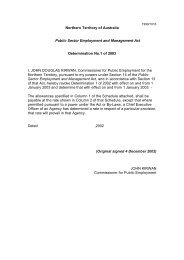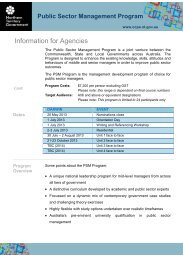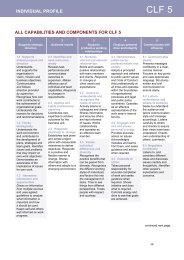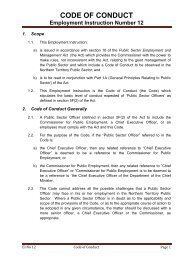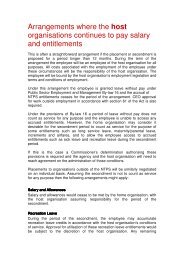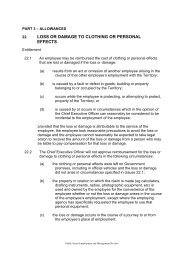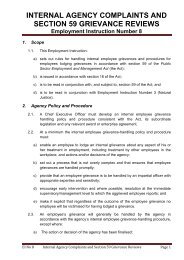Making Workforce Planning Work in the NT Public Sector
Making Workforce Planning Work in the NT Public Sector
Making Workforce Planning Work in the NT Public Sector
Create successful ePaper yourself
Turn your PDF publications into a flip-book with our unique Google optimized e-Paper software.
Hard to fill job groupsHard to fill job groups are those that have enough people<strong>in</strong> <strong>NT</strong> or Australia to fill <strong>the</strong> jobs but generally people donot want to do <strong>the</strong>se jobs for a range of reasons – suchas, <strong>the</strong> nature of <strong>the</strong> work, <strong>the</strong> salary levels, <strong>the</strong> location,<strong>the</strong> career opportunities and so on. If you have hard tofill job groups on your mission critical job group list <strong>the</strong>nyou need to consider retention and recruitment strategiesthat address redesign, work<strong>in</strong>g arrangements, grow<strong>in</strong>gyour own workforce, attract<strong>in</strong>g <strong>the</strong> underemployed and<strong>the</strong> underutilised labour market (that is, people who have<strong>the</strong> skill sets you are look<strong>in</strong>g for but who do not wish to work full time and areseek<strong>in</strong>g alternative work<strong>in</strong>g arrangements).Risk assessmentAgencies can determ<strong>in</strong>e <strong>the</strong>ir own risk assessment methods for workforceplann<strong>in</strong>g. These can be aligned to o<strong>the</strong>r bus<strong>in</strong>ess risk assessment methods, assimple as high, medium or low risk, or more sophisticated such as:• m<strong>in</strong>or short-term – can be managed with<strong>in</strong> workplace• susta<strong>in</strong>ed – cannot fill critical job group and <strong>the</strong>refore will have a susta<strong>in</strong>edimpact on <strong>the</strong> capacity to deliver service (<strong>the</strong> agency will need to consideralternative service provisions).• major – service will need to close.Tips:• Do not forget your supplysource is right <strong>in</strong> frontof you – <strong>the</strong> currentemployees will tell you whypeople are attracted to youragency and why <strong>the</strong>y go.• When hav<strong>in</strong>g difficultyattract<strong>in</strong>g supply, rememberto recruit for match andattitude first.The question you need to ask is: What is<strong>the</strong> risk to this agency of not attract<strong>in</strong>g orreta<strong>in</strong><strong>in</strong>g <strong>the</strong> number of employees requiredfor this job group?Supply source analysisIdentify<strong>in</strong>g supply source can be one of <strong>the</strong> more difficult workforce plann<strong>in</strong>gtasks. If your agency has aligned your job groups/job families to ANZSCOcodes (Australian and New Zealand Standard Classification of Occupations),you can simply look up <strong>the</strong> code and <strong>the</strong>n search <strong>the</strong> ABS data to determ<strong>in</strong>e36



